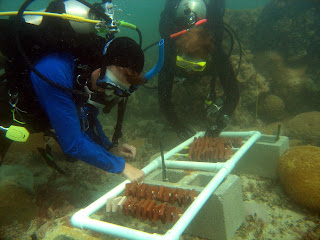
Cindy Lewis and Mary Alice Coffroth pounding in the rebar to anchor the frame in place.

Positioning the settlement tiles with new recruits in the frame

The frame completed and in place

Welcome to the BURR Lab's Coral Spawning Blog for 2009. We are hoping to collect spawn from Montastraea faveolata during August. We will be working out of the Keys Marine Lab on Long Key. Check back for periodic updates -- the team converges in Long Key starting Aug. 5. (Photo by A. Szmant)

















The Team (from left to right)
Vinny Cordero (NOVA Southeastern Univ),Maia Mukherjee (Florida Atlantic Univ), Gabi Jackson (Central Washington Univ), Daniel Poland (Univ at Buffalo) Ewelina Rubin (NOVA Southeastern Univ), Atsushi Fujimora (NOVA Southeastern Univ), Zach Ostroff (NOVA Southeastern Univ). Not pictured Ann Liu (Univ at Buffalo),Chris Lapoint (NOVA Southeastern Univ), Harmony Hancock (NOVA Southeastern Univ), Steve Hancock (Temple Univ), Sarah Briggs (NOVA Southeastern Univ)
 Coral divers changing out air cylinders as the sun sets, preparing for the second dive of the night.
Coral divers changing out air cylinders as the sun sets, preparing for the second dive of the night. Dr. Mary Alice Coffroth (SUNY at Buffalo) sorting the collected gamete bundles
Dr. Mary Alice Coffroth (SUNY at Buffalo) sorting the collected gamete bundles Ann Lui and Daniel Poland (SUNY at Buffalo).....
Ann Lui and Daniel Poland (SUNY at Buffalo)..... ...and Atsushi Fujimura (NOVA Southeastern University)
...and Atsushi Fujimura (NOVA Southeastern University)